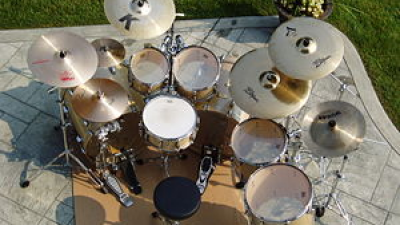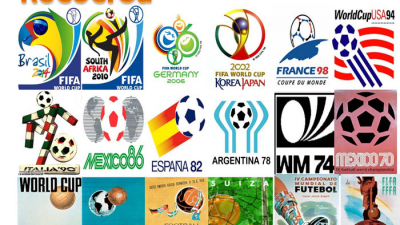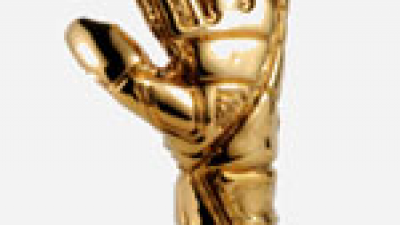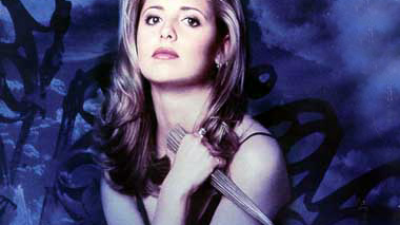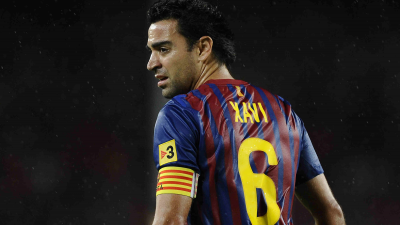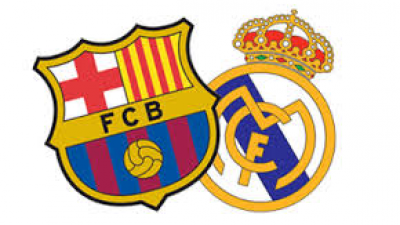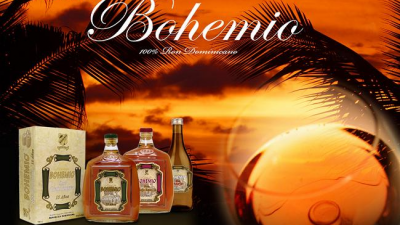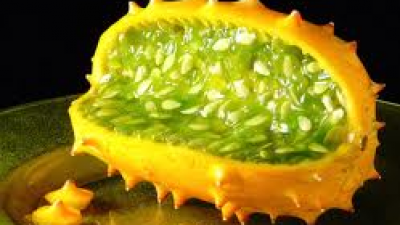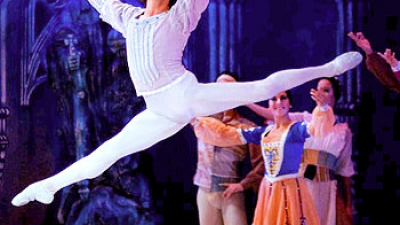The best jazz bassists in the world
|
MUSIC
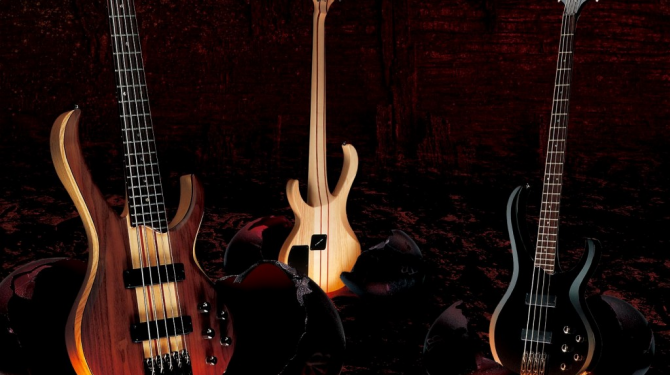
Source: listas.20minutos.es
TOP 25:
Gerald Veasley
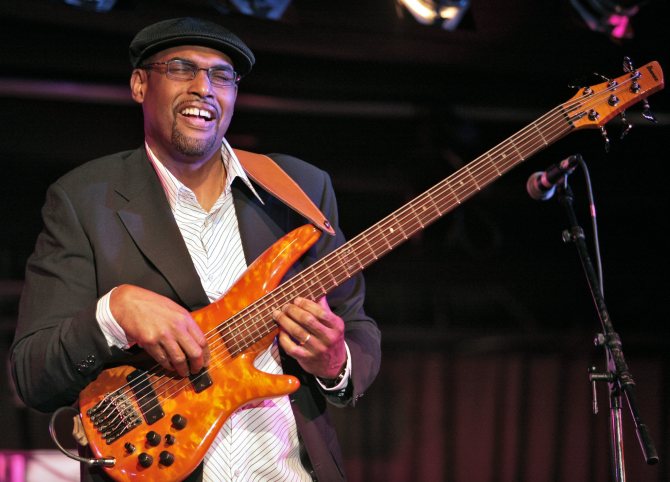
Gerald Veasley (born July 28, 1955) is an American jazz bass guitarist. Veasley was born and raised in Philadelphia, Pennsylvania, where he played in R&B groups as a teenager. He worked with Joe Zawinul 1988-1995, and began releasing his own records in 1992. In addition, he has done extensive work as a studio musician. His 2008 free movement reached number 12 on the US album list. Billboard Top Contemporary Jazz. [1] [2] Veasley has also worked as a good jazz DJ at WJJZ in Philadelphia.
TOP 24:
Tetsuo Sakurai
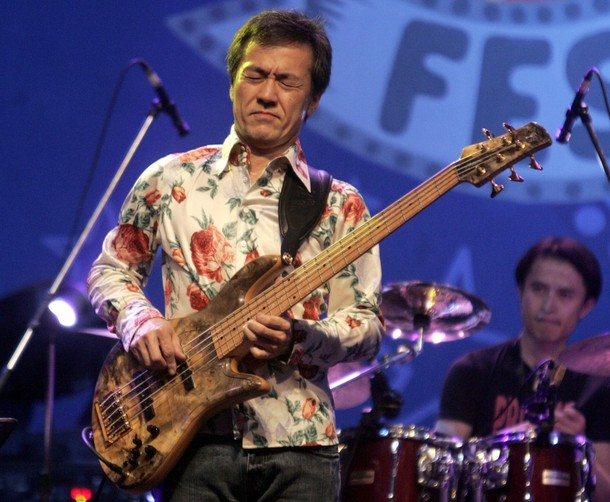
Tetsuo Sakurai (樱井 (桜 井) 哲夫 Sakurai Tetsuo?, Born 11/13/1957) is a Japanese bass player. [1] To date, he has published a total of 37 albums as a member of Cassiopeia and Jimsaku and solo artist, and has also made 3 under instructional videos. Tetsuo Sakurai started playing bass when he was 13 years old. In 1976, Sakurai, with Issei Noro, founded the fusion jazz band Casiopea in 1976. He released 19 albums while in Cassiopeia, but later left the group with Akira Jimbo in 1989 due to musical differences. Both then went on to form a new jazz fusion supergroup, Jimsaku. Jimsaku was active for nine years, until 1998, when it dissolved and both Sakurai and Jimbo went on to pursue a solo solo career. Sakurai TLM20's third solo album, released in 2000, was recorded live in a concert with members of Cassiopeia Issei Noro and Minoru Mukaiya, Akira Jimbo, and Kazuki Katsuta of Dimension. The fourth solo album Gentle Hearts, released in 2001, was recorded with Greg Howe and Dennis Chambers. The fifth solo album Cartas do Brasil was released in 2003 and was a ballad covered vocal album recorded in Rio de Janeiro with Djavan, Ivan Lins, Rosa Passos and other artists. [Who? ] In 2004, Tetsuo tour with Greg & Dennis. The following year, the live performances excursion was released on DVD titled Gentle Hearts Tour 2004. Sakurai is currently composing and playing her own music as a soloist with national and foreign musicians.
TOP 23:
Chris minh doky
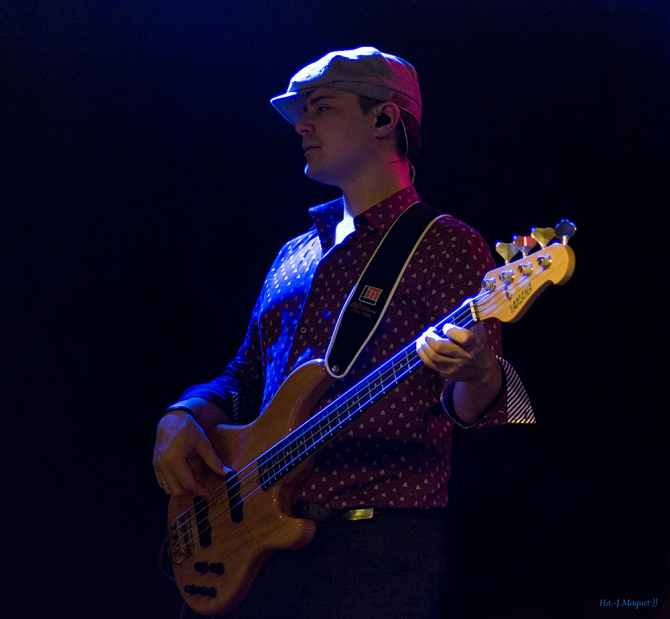
Chris Minh Doky (born February 7, 1969) is a Vietnamese - Danish bassist who lives in Copenhagen and New York City. [1] Although Doky has worked in many genres, his main area of music is jazz. [2] He released his first album, Appreciation, in 1989 [3] only 4 years after picking up the instrument. As a sideman, he has collaborated mostly with the Mike Stern Band, [4] Michael Brecker Quartet, [5] Trilok Gurtu and crazy Santos, Ryuichi Sakamoto [6] and David Sanborn. As a soloist, he is one of the most successful bassists of his generation. [7] Its sound is often described as a mixture of the native Scandinavian tradition, with the feeling of its country of adoption, the United States. [8] His wife, Tanja is a bridesmaid of Princess Mary of Denmark. Personal Thanks Thomas Clausen, Chris Minh Doky, Ben Perowsky, Larry Schneider, 1989 The sequel to Personal Chris Minh Doky, Niels Lan Doky, Bill Evans, Adam Nussbaum, Ulf Wakenius, 1990 Personal Letters Randy Brecker, Chris Minh Doky, Adam Nussbaum, 1991 Minh Personal Jim Beard, Michael Bland, Michael Brecker, Randy Brecker, Hiram Bullock, Joey Calderazzo, Joe Caro, Chris Minh Doky, David Gilmore, Larry Golding, Lalah Hathaway, Lasse Janson, Norbert Lucarain, Adam Nussbaum, Chris Parks, Ricky Peterson, Dianne Reeves, Alex Riel, David Sanborn, Vivian Sessoms, Mike Stern, Lenny White, Louis Winsberg, 1998 Doky Brothers Personal Chris Minh Doky, Niels Lan Doky, Alex Riel, Klaus Suonsaari, Anders Mogensen, Ulf Wakenius, Curtis Stigers, Deborah Brown, Michael Brecker, Randy Brecker, Frank Stangerup, 1995 Doky Brothers 2 Staff Chris Minh Doky, Niels Lan Doky, Al Jarreau, Sanne Salomonsen, Gino Vannelli, Dianne Reeves, Toots Thielemans, John Scofield Louis Winsberg, David Sanborn, Bill Evans, Randy Brecker, Terri Lyne Carrington, Jeff Tain Watts, Riel Axel, Anders Mogensen, Jeff Boudreaux, Mitch Forman, Trilok Gurtu, Xavier Dessandre Navarra, Dany Munyongo Jackson, Randy Cannon, Sharon Full, Chris Parks, Paul Mazzio, Joyce Imbesi, 1996 Listen Up! Personal Katreese Barnes, Randy Brecker, Chris Minh Doky, Kenny Garrett, Larry Goldings, Makoto Ozone, Clarence Penn, Adam Rogers, John Scofield, George Whitty, Louis Winsberg, 2000 Chris Minh Doky 2002 Cinematique Personal Chris Minh Doky, Jeff Tain Watts, Bill Stewart, Clarence Penn, Joey Calderazzo, Larry Golding, Makoto Ozone, Toots Thielemans, Biréli Lagrène, 2003 Nomad Diaries 2006 Scenes from a dream, Personal Chris Minh Doky (acoustic bass)! ; Larry Goldings (piano); Peter Erskine (drums); Joke Schonewille (harp); Doesjka Deleu, Seija Teeuwen, Herman Van Haaren, Lucja Domski, Rubén Margarita, Marianne Van Den Heuvel, Erica Korthals Altes, Dennis Koenders, Tinka Regter, David Peijnenborgh, Wim Kok, Marijn Rombout, Pauline Terlouw, Elizabeth Liefkes, Ernö Olahol Violin ); Isabella Petersen, Aimee Versloot, Norman Jansen, Iris Schut, Julia Jowett (viola); Annie Tangberg, Maarten Jansen, Wim Griñán, Bastiaan Van Der Werf (cello); Hans Vroomans (piano); Eddy Koopman, Murk Jiskoot (percussion). , 2010
TOP 22:
will lee
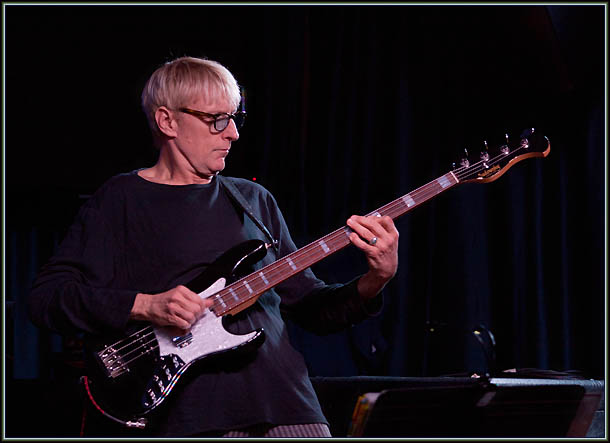
Will Lee is an American bassist, vocalist, composer and music producer, winner of a Grammy Award and one of the most successful session musicians in the world. Will Lee, known under the name of Uncle Bill by the fans, was born in San Antonio, Texas on September 8, 1952. His parents, both professional musicians, encouraged him from a very young age to the study of music, so that childhood de Will passed between piano, violin, trumpet and French horn lessons.2 When he discovered The Beatles in the program The Ed Sullivan Show he decided to go on drums and at the age of 12 he had already formed his first semi-professional band, with which I played surf-rock classics in Florida venues. Will would spend the rest of his adolescence playing with different professional bands, and when he discovered that the role of drummer had less demand than that of bassist he decided to adopt this last instrument. In the late 1960s, Will Lee decided to formalize his musical education by enrolling at the University of Miami, where he studied French as a year before addressing the specialization in electric bass. In the evenings, the tireless Lee played in different local bands, sometimes as a bassist, sometimes as a drummer and sometimes with a trunk. The ability that young Lee showed with all the instruments attracted the attention of the trumpeter Randy Brecker who invited him to move to New York to participate in his recent project Dreams, specifically in his second album Imagine my dreams, recorded in 1972 with Michael Brecker and Billy Cobham. The arrival in New York meant a huge push for the bass player's career, who soon found himself touring with the most important stars of the moment: Bette Midler, George Benson, Diana Ross or Liza Minnelli, among others. Since then, to his activities as a companion of great stars we must add a huge record as a studio musician (Lee has recorded for virtually all the great American pop and rock stars of 30 years to this part), an incessant activity in the production of advertising jingles, and, above all, their participation in The World's Most Dangerous Band, the incredible orchestra of the Late Night with David Letterman program of which the bassist is, since 1982 a founding member and for which he is particularly recognized in the U.S. Today the musician continues to maintain a very busy schedule of collaborations, both in studio and live. As a session musician, a large part of the recordings that Will Lee has made throughout his long career has been anonymous. Even so, the musician has one of the greatest trajectory of referenced collaborations in the world.3 Among the artists and musicians that Will Lee has collaborated with are: Bette Midler, The Brecker Brothers, Barry Manilow, Tatsuro Yamashita, Mariah Carey, Carly Simon, George Benson, Bob Mintzer, Steely Dan, Donald Fagen, BB King, Cat Stevens, Michael Bolton, Ringo Starr, Gloria Estefan, Miami Sound Machine, Cyndi Lauper, James Brown, Cher, Al Green, Billy Joel, Liza Minnelli Frank Sinatra, Carl Perkins, Kiss, Ace Frehley, Barbra Streisand, Diana Ross, David Sanborn, Spyro Gyra, Ricky Martin, Natalie Cole, Roy Buchanan, BJ Thomas, Horace Silver, Herbie Mann, Boz Scaggs, Diane Schuur, Tom Scott , Neil Sedaka, Carly Simon, Phoebe Snow, Ronnie Spector, The Spinners or Steely Dan, among many others. Will Lee has developed most of his career as a session musician at the service of artists of more or less commercial genres and has preferred to limit his artistic career to a few more personal projects, such as the two albums he has so far performed as a soloist, or his collaborations in Dreams and other supergroups such as Smappies or 25th Street Band, two superbands composed of American session musicians who have recorded several albums available exclusively in Japan. However, the commercial nature of most of Will Lee's work reflects his artistic side. Lee's professionalism consists in providing a characteristic touch of authenticity to all his works, even the most clearly commercial ones. Wil Lee is probably the most versatile bassist of recent times, 4 has an encyclopedic domain of pop music patterns, a privileged ear and his groove is considered among the most powerful in history.4 Among his most immediate influences, Will Lee quotes The Beatles, Stevie Wonder, Jimmy Hendrix, Sly & the Family Stone and bassists Chuck Rainey, James Jamerson and Willie Weeks.5 The bassist has preferably used Fender Precision bass at the beginning of his career, but for years he has been associated with the firm Sadowsky, which recently announced the commercialization of a model with the name of the musician.
TOP 21:
Mike Pope
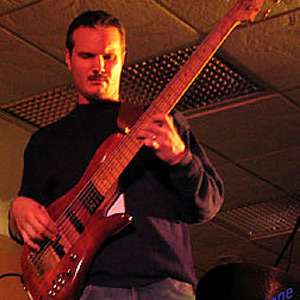
Mike Pope is a virtuoso American bassist and bass player of jazz and jazz fusion. Born in a family of strong musical tradition (Pope's parents and brothers are also musicians), Mike Pope began playing the piano as soon as he could reach the keys. Although his parents were jazz lovers, they heard, above all, classical music, while the brothers of the young Pope introduced him to the world of rock and pop by showing him albums by Pat Boone, Kiss, Emerson Lake and Palmer, Rush, Jeff Beck or The Beatles. A few years later Pope was interested in the recordings of the jazz fusion figures of the late 70s, such as Return to Forever, Pat Metheny, Weather Report, or The Brecker Brothers. From a young age, Pope himself claims to have felt an inclination for the bass lines that he always played on the piano as a counterpoint to the harmony that his right hand was delineating. It was his parents who suggested to Pope that perhaps he should consider devoting himself to the electric bass guitar, buying young Mike (who at the time was 11 years old) his first bass, a copy of Gibson. Pope began his classes with Jeff Halse, whom he recognizes as one of the most important influences in his development as a musician. Jeff exposed Pope to the recordings of great jazz musicians, such as Ron Carter, Ray Brown, John Coltrane or Charlie Parker (Pope already knew Jaco Pastorius and Stanley Clarke) while encouraging him to adopt double bass and study jazz. At 16 he discovered John Patitucci and was fascinated by his way of playing the 6-string bass, an instrument still relatively strange in the mid-80s. Pope received a couple of lessons from Patitucci, with whom he joins a solid friendship and who He introduced the young bass player to Chick Corea, who did not hesitate to sign him for some of the editions of his Elektrik Band.1 Pope spent some years playing with various musicians from the local scene before moving to the University of North Texas, where he would establish contact with numerous musicians, including the late Michael Brecker, who eventually convinced the musician to move to New York. In the jazz capital, Mike Pope would soon make a name among the greatest figures on the planet thanks to his enormous ability with the instrument in the jams. In 1997 he met Vinny Fodera, a prestigious luthier for whom Pope began to design the previous series models would take, towards the 1998 series. In 2005 he moved with his family and his two daughters to Maryland, where he continues to accompany artists with both the electric bass and double bass. Currently, in addition, he owns Mike Pope Design2 company through the sale of the preamps that Pope himself designs and manufactures and that, some models of the prestigious firm Fodera continue to mount as standard.3 Mike Pope remains a frequent presence in the best jams from New York. The tremendous talent as bassist of Michael Pope, both on the electric bass and on the double bass, along with his skills as a composer and arranger are precisely reflected in his two solo projects so far, Walk Your Dogma (1997) and The Lay Of The Land (2002) .4 Pope is also a respected music educator, and has appeared on various campuses and specialized festivals such as Bass Day, next to titans such as Matthew Garrison, Dominique Di Piazza or Victor Wooten. 4 Regular contributor to different specialized magazines in the world of electric bass his article "Adventures In 6-String: By Mike Pope" published in the December 2008 issue of Bass Player5 magazine is a reference in the scant bibliography on Bass of extended range and was chosen by the readers of the aforementioned publication as "Best article of the year.
TOP 20:
Jimmy Haslip
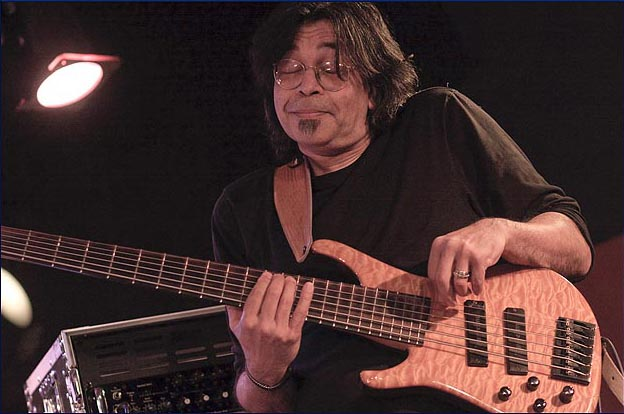
Jimmy Haslip is an American jazz and jazz fusion bassist. Born in the Bronx neighborhood of New York, Jimmy Haslip grew up in a musical environment. As a child he learned to play percussion, but when his older brother sent him recordings of jazz and classical music artists he decided to start his musical studies, starting with the trumpet. With 15 years, Jimmy tested for the first time an electric bass guitar, an instrument that he declares to be practically self-taught. In the mid-1970s, however, he had the opportunity to receive private lessons from the legendary Jaco Pastorius, which, he admits, was a giant step in his career.1 In 1977, alongside Robben Ford, Russell Ferrante, and Ricky Lawson, forms The Robben Ford Group, which four years later and after the departure of Ford (replaced by Marc Russo), would be renamed the Yellowjackets.2 Since 2010, he has been part of the relaunched Jeff Lorber Fusion group, with whom he has recorded, as an interpreter, producer and arranger, the three albums of the new era. One of the outstanding disciples of Jaco Pastorius, 3 Jimmy Haslip is known above all for his participation in Yellowjackets, of which he is a founding member. One of Haslip's technical particulrities is that, despite being left-handed, it does not change the position of the strings of its instruments, so that its execution technique is radically far from the standard technique.4 Even so, Haslip is one of the great specialists of the fretless bass, 5 in which he performs frequent and complicated solos, 6 but also displays his virtuosity in the acoustic bass, the electric bass and the electric bass.3 His amazing technical mastery places him among the main exponents of the instrument within the jazz fusion genre complex, and has earned him two Grammy awards and 11 nominations.7 The musician quotes Paul McCartney, James Brown, Tito Puente, Chick Corea, Jimi Hendrix, Béla Bartók, Mozart, Chick Corea among his musical influences Antonio Carlos Jobim, Wayne Shorter, Joe Zawinul, Jaco Pastorius, Charles Mingus, Miles Davis, Nicolas Slominski, John Coltrane, Thelonious Monk, Sting, Peter Gabriel, Joni Mitchell, Count Ba sie or Duke Ellington, among others.
TOP 19:
Nathan east
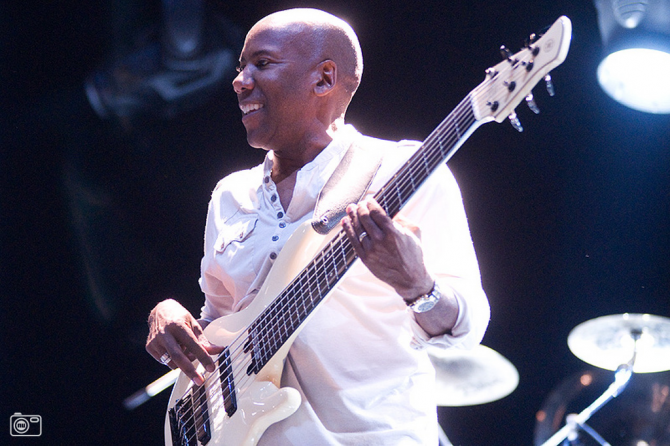
Nathan East is an American bassist and music producer. Born in a family of seven brothers on December 8, 1955, in Philadelphia (Pennsylvania), Nathan East moved to San Diego (California) with only four years. East learns to play piano as a child, and goes to cello a little later. With 14 years he follows in the footsteps of his brother David, also a bassist, and adopts his definitive instrument, with which he begins to play in groups of churches and other local bands. In his high school days he joined a band called Power, which is used as a base band on the tour of some Stax artists, which attracts the attention of Barry White, who hires the band for their national tour. In this way East - still a teenager - begins his professional career as a member of the Love Unlimited Orchestra in such important places as the Madison Square Garden or the Apollo Theater.1 Nathan East spends a few years at the University of California of San Diego, and after graduating in Musical Arts heads to Los Angeles to begin a lucrative career as a session musician. In the early 1980s, veteran arranger and composer Gene Page hired East to record some jingles. Impressed by his technical ability and his ability to read, Page uses East in various projects that include recordings with Dionne Warwick and Johnny Mathis. Nathan East's reputation as a session musician does not stop growing, and from that point on, he becomes one of the most requested bassists, working for Lionel Richie or Kenny Loggins before joining Eric Clapton's band at the end of the decade.1 In 1990 he formed the Fourplay supergroup, together with the artist Bob James, guitarist Lee Ritenour and drummer Harvey Mason. The band's first album was released in 1991, selling half a million copies and remaining in the top position of the Billboard charts for 33 weeks, in the contemporary jazz category. In 1993 a second album appears that turns into a gold record and obtains a Grammy Award nomination. In 1995 appears Elixir, new gold record and number one on the charts for 92 weeks, while 4, of 1998 obtains a similar result, endorsing the success of a band whose last record so far comes to light in 2010, with the title Let's Touch the Sky.1 The impressive career as an East session musician continues to parallel his activity with Fourplay in recent decades, playing and recording with musicians such as Sergio Mendes or Marcel East, with whom he maintains a band called Two Faces of East . Also, the bassist has edited a didactic video titled Contemporary Electric Bass.1 Assessment and influences Influenced by bassists such as Ron Carter, Ray Brown, Charles Mingus, Buster Williams, Scott LaFaro, James Jamerson, Larry Graham and admirer of Pino Palladino, Steve Rodby and Marcus Miller, 1 2 Nathan East one of the most respected session musicians in the industry, having participated in the likes of Barry White, Al Jarreau, Kenny Loggins, Eric Clapton, Phil Collins, Dionne Warwick, Johnny Mathis, Lionel Richie, Kenny Loggin, Sergio Mendes, Marce East, Fourplay, Whitney Houston, Madonna, Michael Jackson, Daft Punk, Elton John, Anita Baker, Herbie Hancock, George Harrison, Joe Pass, Stevie Wonder, Bob Dylan, Ray Charles, George Benson, Frank Sinatra, Sammy Davis, Jr., Tom Jones, BB King, Chaka Khan, Steve Vai, Natalie Cole, Toto or Sting, among many others.3 His popularity among the musicians' community has earned him the bass player award better v hosted by the International Rock Awards, 1 and has led Yamaha to market an instrument with its name.
TOP 18:
James Genus
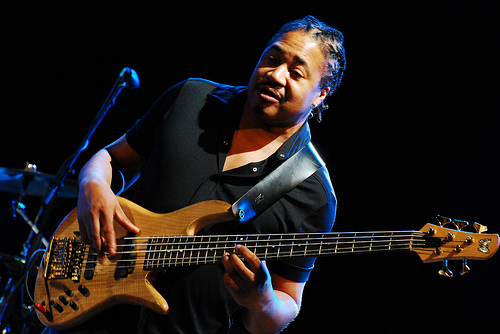
James Genus is an American bassist and bass player of jazz and jazz fusion. James Genus had begun to play the guitar from an early age, but inspired by Larry Graham's albums, he switched to bass at the age of 13. After acquiring a Precision model and picking up the influence of Jaco Pastorius and Stanley Clarke, he starts playing with different local musicians, among whom were the Wooten brothers.1 After graduating from High School in 1983 he entered Virginia Commonwealth University, in Richmond , where he receives classes from Ellis Marsalis (who would end up sponsoring him) and studies double bass, because the institution did not offer electric bass classes. James spends part of that time playing with bassists Victor Wooten, Oteil Burbridge, or Keith Horne, as well as drummers Carter Beauford, Billy Drummond, and Clarence Penn. After graduation in 1987 he moved to New York, where he soon established himself as a reputed and requested bassist and session bassist.2 Currently, he is part, among many other projects, of the prestigious band of the American program Saturday Night Live. With an impressive discography as a session musician that encompasses tandiverse styles such as hip hop or the most authentic jazz, 4 James Genus is among the doublers (musicians who equally dominate both the electric bass and double bass) in the world.5 Gifted With enormous versatility and musicality in both instruments, Genus moves freely in all fields, and stands out as both an accomplished companion and the brilliant soloist he is. Among the many artists who have had the collaboration of Genus in recordings and tours we can mention Out of the Blue (1988-89), Horace Silver (1989), Roy Haynes and Don Pullen (1989-91), Nat Adderley (1990 ), Greg Osby and New York Voices (1990-91), Jon Faddis (1991), TS Monk (1991), Benny Golson (1991), Dave Kikoski (1991), Bob Berg (1991-96), Geoff Keeze (1992 ), Lee Konitz (1992), Michael Brecker and The Brecker Brothers (1992-96), Bob James (since 1994), Michel Camilo (since 1995), Elysian Fields (since 1995), Branford Marsalis (1996), Chick Korea ( 1996), Dave Douglas (1996), Uri Caine (1997), Global Theory (1997), Bill Evans (saxophonist) (2005), Herbie Hancock (2008) or Daft Punk (2013), in addition to Horace Silver, Branford Marsalis, David Sanborn, Bob Berg, or Steps Ahead.
TOP 17:
Mark Egan
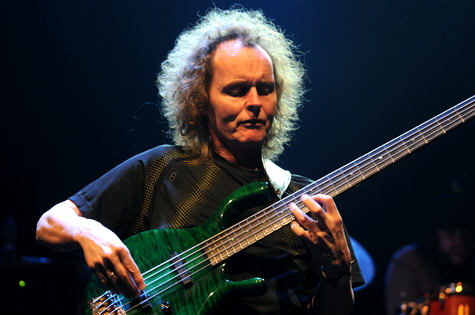
Mark Egan is an American jazz and jazz fusion musician, specializing in the fretless bass, known above all for being part of the first version of the Pat Metheny Group (1977-1980) and for his long association with the Elements fusion group . Born in Brockton, Massachusetts, on January 14, 1951, Mark began his musical studies with only 10 years. Under the strong influence of his father, an enthusiastic trumpeter, the young Mark adopted this instrument, with which he would begin his professional career in different orchestras and groups of Rhythm & Blues and from which he would become a small local legend for his great ability with the instrument However, with 16 years, thanks to his interest in the rock stars of the moment (Jimi Hendrix, Cream, Miles Davis, Ravi Shankar, The Beatles or the Motown artists), he decided to change to the electric bass, which, since then He would become his main instrument.1 Egan enrolled in the prestigious Miami School of Music in Florida, where - like his colleague Michael Manring - he would receive private lessons from Jaco Pastorius himself, and where he would form a band with other students (between those that were the keyboardist Clifford Carter or the guitarist Hiram Bullock) with whom he would appear in New York in 1976. There Mark quickly became known for his skills with the instrument, and was recruited by Eumir Deodato or David Sanborn for different recordings and concerts. Another notable member of the Miami School of Music, Pat Metheny noticed the bassist's talent, and signed him for the first formation of which he would become his flagship band, the Pat Metheny Group, a group with which Mark Egan worked until 1980 since through which he met who since then would become his practically inseparable musical partner, drummer Danny Gottlieb. It was precisely with the latter with whom Egan founded the Elements group in the early '80s, a band that would remain active until today and with which at the artistic and compositional level, the bassist has always been strongly linked. In the mid-1980s Mark Egan would record his solo debut, the Mosaic album and, since then, he has developed an incessant activity as a musician and composer, always maintaining a high artistic level in projects as diverse as his collaborations with singer Marianne Faithful or saxophonist Bill Evans. In addition, he has launched Wavetone records (his own record label under which he launches his own works and those of his collaborators and friends) or Electric Fields (a high-tech recording studio), and in parallel has maintained a teaching activity that He has led to the editing of Bass Workshop, a didactic method for bassists, as well as continuing to cultivate his interest in Eastern philosophy, yoga or meditation. Although Egan has a collection of more than 30 instruments, his figure has always been associated with that of the American firm Pedulla, of which he is a representative and who has expressly designed for him a curious double-neck instrument, the first fretless and the second of 8 strings. In the enormous curriculum of collaborations of Mark Egan, three gold and three platinum records are included, innumerable recording and composition sessions for film and television, tours with artists of a huge stylistic range and a good amount of concerts on bass alone. Among the artists for whom Egan has worked we can mention, among many others,: Flora Purim, Airto Moreira, Danny Gottlieb, Pat Metheny, Marianne Faithful, Bill Evans, Hiram Bullock, Clifford Carter, Arcadia, Elements, the Gil Evans Orchestra, Joan Osborne, Michael Franks, Rory Block, David Sanborn, John McLaughlin, Sophie B. Hawkins, Serious Ken, Barbieri Cat, Dave Matthews, Mark Murphy, Jim Hall, Joe Beck, Dave Liebman, Terumas Hino, Gil Goldstein, Mike Stern, Sonny Fortune, Randy Brecker or Eliane Elias Mark Egan is one of the most respected and most demanded session bassists today. Outstanding student of Jaco Pastorius, whose influence he openly acknowledges, 2 is part, along with Michael Manring, Pino Palladino, Alain Caron or Kai Eckhardt, of the small avant-garde of elite bassists who, starting from the revolution initiated by Pastorius, have continued to develop the language and limits - increasingly wide - of fretless bass in avant-garde jazz. Egan has a unique and very special sound, due to his absolute mastery of the art of microtone handling, an impeccable technique and tuning, and an almost perfect ear.
TOP 16:
Jeff Berlin
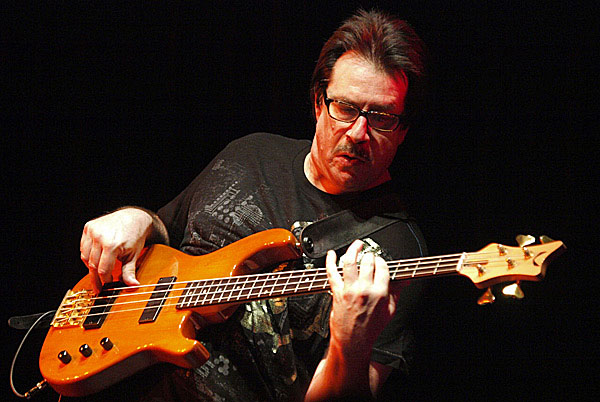
Jeff Berlin is an American bass player, one of the first virtuosos of his instrument (along with Jaco Pastorius and Stanley Clarke) and an essential reference for the history of the electric bass because of the large number of technical innovations he has brought. Born in a family of strong musical tradition (his father sang opera and his mother played the piano), Jeff Berlin was already considered a child prodigy when, at the age of 14 he decided to leave the violin for the electric bass, motivated primarily by his admiration for Jack Bruce, bassist of Cream1 In the early '70s, Berlin studied for some time at the prestigious Berklee College of Music before settling in New York in 1975, where he would meet guitarist Allan Holdsworth and legendary jazz drummer Tony Williams His works with both quickly introduced him to the New York scene, where he immediately began collaborating as a sideman with countless artists such as Pat Martino, Gil Evans, Toots Thielemans, Al DiMeola, George Benson, Earl Klugh, Larry Coryell, Bob James, Dave Liebman , Herbie Mann, or Ray Barretto, among others. Berlin became part of the Bill Bruford band in 1977, recording four albums for Allan Holdsworth on. From there, Berlin would move to Los Angeles, where he would continue his session work and where he would establish himself as a renowned educator, founding several centers, including the Bass Institute of Technology. Berlin would record his first solo albums, and collaborate with other artists such as Frank Zappa before finally changing his residence to Florida, where he founded his Players School institute and where he has resided since then. In recent years Jeff Berlin has recorded with Yes, John McLaughlin, Billy Cobham or the Japanese guitarist Kazumi Watanabe, among an endless list of important artists. On August 30, 2013, he married Gabriela Sinagra, an Argentine singer who specifies teaching. Jeff Berlin is considered by many to be one of the best bass players in history.2 Recognition towards the bass player has often come from his colleagues by profession, and thus, Jaco Pastorius himself said of Berlin that he was much better soloist than he; Rush's Geddy Lee referred to Berlin as "the best bass player on the planet"; and Marcus Miller once said that he had always aspired to become the "black Jeff Berlin" .2 Endowed with an impressive technique, an amazing melodic fluency and an enviable ear, the sound of Berlin has a very particular flavor that, in part is reminiscent of Jaco's sound (although Berlin has used bass with frets in most of his career and has expressed his rejection for the innumerable pastorius3 imitators) 3 and that, in part, is due to his interest in rock music Pioneer in the use of slap4 and two-handed tapping, 5 Berlin has always sought to distinguish itself from other bassists, abandoning these styles as they became part of the general domain Jeff Berlin is also known for his defense of formal education in music; in addition to having founded the Bass Institute of Technology in Los Angeles and its' Players School of Music in Clearwater, Florida, Berlin is the author of numerous articles and teaching methods, do nde stands out for its particular theory that music must be taught substantially through content of a formal musical nature, leaving aside materials such as tuners, metronomes or tablatures. Jeff Berlin is currently touring the most important jazz festivals and clubs in the world with his own group that regularly includes other figures of worldwide relevance such as Danny Gottlieb, Paul Wertico, Othello Molineaux, Randy Brecker or Richard Drexler. In addition, the musician has participated in the BX3 project, along with Stuart Hamm and Billy Sheehan.
TOP 15:
Steve Bailey
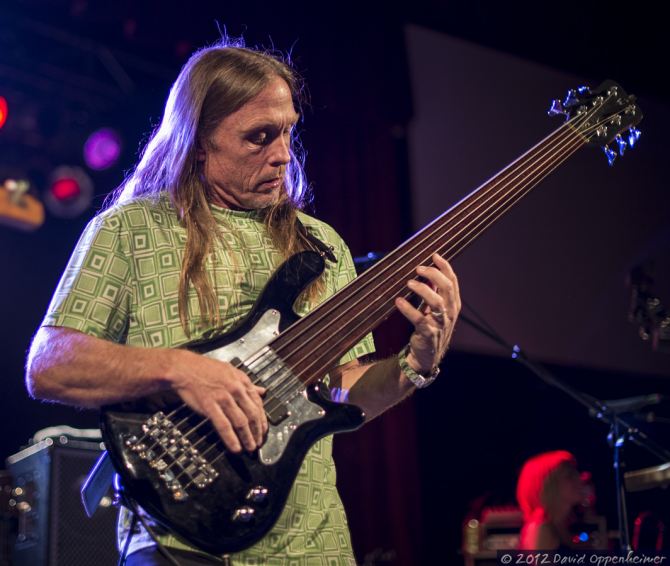
Steve Bailey, born February 10, 1961, is an American bass player famous for his work with the 6-string fretless bass. He has been chosen as "Bassist of the Year" in 1994 and 1996. Steve Bailey started with the bass at the age of 12, directly with the fretless bass ("fretless": fretless). Not only does he play the electric bass, but he also plays the double bass. He started in his musical career after listening to Stanley Clarke on the Return to Forever ensemble. He is currently a professor at the University of North Carolina at Wilmington. As a studio musician he has made numerous collaborations, including several albums with bassist Victor Wooten. Bailey and Wooten have created "Bass At the Beach", a camp for bass players of all levels. Steve Bailey is also a renowned surfer. Steve has played with a large number of artists, including Victor Wooten in Bass Extremes, Paquito D'Rivera, Dizzy Gillespie, James Moody, Dave Liebman, Claudio Roditti, Michel Camilo, The Rippingtons, David Benoit, Jethro Tull, Lynyrd Skynyrd, Willie Nelson, Ray Price, Billy Joe Shaver, Larry Carlton, Emily Remler, Brandon Fields, Kitarō, Max Highstein, Tab Benoit, Johnny Witherspoon, Toni Price, Mel Tormé, Ernestine Anderson, Mark Murphy, John Patitucci, Billy Sheehan among many others. Steve plays with "Ampeg" amplifiers and uses custom bass from the Japanese firm Aria, as well as a six-string fretless bass guitar equipped with a pair of "Basslines Humbuckers" dual coil pickups, with 18V pre-active and 3-band EQ, manufactured expressly for him by Fender. Bailey uses D'Addario EXLS510 strings. Currently, Steve has Fender Endorsement, and besides that, he already has a signature model of this brand.
TOP 14:
tal wilkenfeld
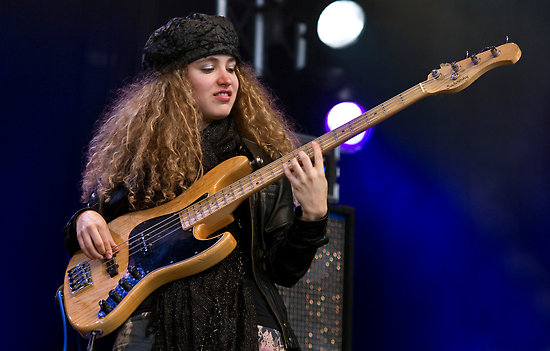
Tal Wilkenfeld is an Australian jazz and jazz rock bassist who develops her professional career in the United States. Born in Sydney, Australia on December 2, 1986, Tal Wilkenfeld began playing the guitar at age fourteen. In 2002, at the age of 16 he dropped out of high school and emigrated to the United States to settle in Los Angeles, California, where he began his musical studies at the prestigious Los Angeles Music Academy. When he was 17, he moved to the electric bass and after graduating in Los Angeles, he moved to New York, where he quickly made a name in the jam sessions scene. In 2006, after recording her debut album, the bassist joins the Allman Brothers Band before being required by pianist Chick Corea and Jeff Beck1, in whose band drummer Vinnie Colaiuta participated. Since then Wilkenfeld's career has been unstoppable, playing alongside notable musicians such as Hiram Bullock, Steve Vai, Eric Clapton, Susan Tedeschi, the Allman Brothers Band, Herbie Hancock, Jeff "Tain" Watts or Wayne Shorter and performing numerous demonstrations and Concerts all over the world. His popularity grows after the appearance with Jeff Beck on the DVD "Crossroads Guitar Festival 2007" (The Festival organized by Eric Clapton for charitable purposes) highlighting in the solo of Cause We've Ended As Lovers. In 2008 Jeff Beck releases the live album, Performing This Week ... Live At Ronnie Scotts having his first appearance integrated into a DVD, sharing the stage with Eric Clapton. In 2010 he recorded his first studio work with Jeff Beck called Emotion & Commotion. One of the great revelations in the jazz scene and one of the most promising figures in the current electric bass scene, 2 Tal Wilkenfeld is considered, by his youth a prodigy by specialized critics.3 Wilkenfeld began with 18 years on bass electric and at 21 he had already recorded his first album, an album that has served to establish himself as one of the most respected bassists on the scene and that is the best example of his work. With all the songs produced and arranged by herself, Wilkenfeld shows in a style reminiscent of Jaco Pastorius and Paul Jackson, 3 a harmonic depth, a technical agility and an ability to "sing" the instrument2 very rare in such short musicians experience. In 2008 Tal Wilkenfeld was voted "The Years Most Exciting New Player" by the readers of the magazine "Bass Player" .4
TOP 13:
matthew garrison
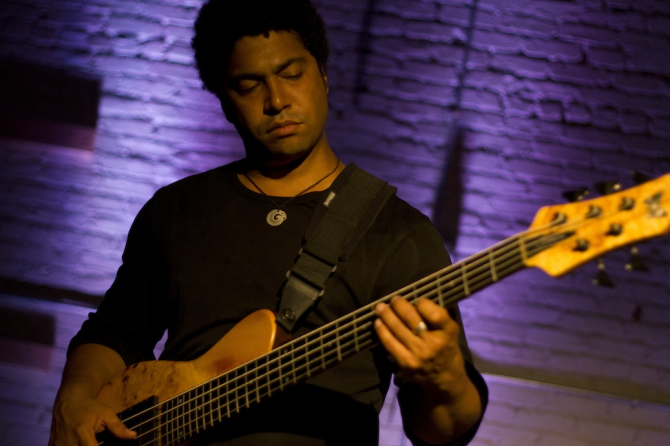
Matthew Garrison is an American jazz and fusion bassist. Son of the double bass player Jimmy Garrison, Matthew was born on June 2, 1970. His father, famous above all for his collaboration with the classic John Coltrane quartet (also composed of Elvin Jones and McCoy Tyner), would record with the saxophonist fundamental works for the Jazz history as "A Love Supreme" or "Ballads", but his death in 1976 forced the family to leave the United States to settle in Rome. There Garrison began his piano and bass studies, but twelve years later, in 1988 he would return to the United States to be welcomed by his godfather, drummer and jazz pianist Jack DeJohnette. During the two years he spent at Dejohnette's house and stimulated by the musical atmosphere that reigned in the drummer's house, Garrison turned himself into a discipline of very severe study, under the direction of legendary bassist Dave Holland and DeJohnette himself, a period that It would be key in its formation. In 1989 he was awarded a scholarship to study at the prestigious Berklee school in Boston, where he began his professional career working as a "sideman" for vibraphonist Gary Burton, guitarist Torsten de Winkel or keyboardist Lyle Mays, among others. At the end of his period in Berkley, Garrison moved, in 1994, to Brooklyn, New York, where he began a brilliant career that would take him to work for the most prestigious artists on the world stage, including Herbie Hancock, John McLaughlin, Chaka Khan Joe Zawinul, John Scofield, Paul Simon, Joni Mitchell, Jack DeJohnette, Steve Coleman, Cassandra Wilson, Wallace Roney, Pat Metheny, Geri Allen, Tito Puente, Michael Brecker, Randy Brecker or Mike Stern. Parallel to his career as a bass player, Garrison develops an important didactic activity, giving private lessons and offering innumerable seminars in academies throughout the country. In 1998 he founded "GarrisonJazz Productions", where the musician promotes and markets his productions since then. Matthew Garrison is a virtuoso of the electric bass and an essential reference in the recent history of the instrument. Creator of an original four-finger pizzicato technique, Garrison also boasts a sophisticated post-bebop phrasing that has its roots in the revolution that Jaco Pastorius brought with it, but that extends Pastorius' language, updating it, modernizing it and developing it. Although Garrison's music shows strong Funk and Fusion influences, he actually dominates almost perfectly all the techniques of his instrument, which makes him one of the most versatile, bright and sought-after session musicians on the American scene, as evidenced by His impressive history of collaborations. With a unique musical personality, an immediately recognizable sound, and a strong orientation towards the composition and support function of the electric bass guitar (which distances it from vain technical exhibitionism), Matthew Garrison is part of the small group of elite bassists who continue opening new and fertile paths for your instrument.
TOP 12:
Alain Caron
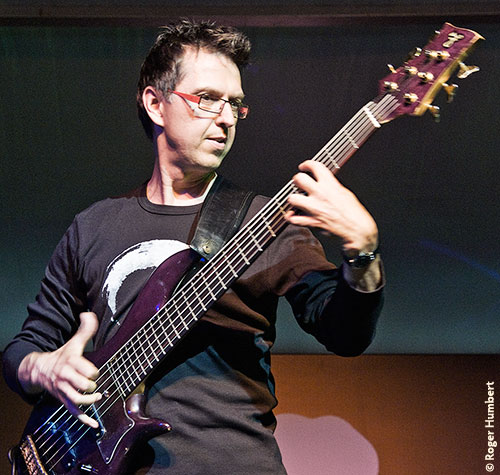
Alain Caron is a Canadian jazz and jazz fusion bassist. Alain Caron's career began with only 11 years, when he discovered his passion for jazz.1 In the early 1970s he moved to Montreal, where he began working as a session musician, while performing concerts in small venues. He enrolls and passes the admission exam at the prestigious Berklee College of Music in Boston, where he establishes a relationship with other students who would end up achieving some notoriety, such as David Kikovsky, Tom Harrell, Sal Nestico, Frank Tiberi, Jerry Bergonzi or Bob Moses.1 In 1977 he became part of the Michel Cusson Group, and three years later, he formed in Quebec the UZEB fusion group, with which he would remain until the early 1990s. In 1993 he formed Le Band, his solo project, with the He continues to work until today while making other collaborations with musicians such as Leni Stern or Gino Vanelli.2 Since then he has performed in places such as Canada, United States, Europe, Africa, Israel, or Japan, and has participated in such important festivals such as the Montreal Jazz Festival accompanying leading figures such as Michael Brecker, Don Alias, Didier Lockwood or Tiger Okoshi3 In 2007 he was named honorary doctor by the University of Québec, in Rimousky. Alain Caron is recognized as one of the greatest virtuosos of his instrument, and one of the most distinctive interpreters of the 6-string fretless bass.3 5 In addition, he is one of the few professionals with an almost absolute technical mastery in the standard electric bass, in the fretless bass and acoustic bass, which makes Alain Caron an essential reference for fans
TOP 11:
Ric Fierabracci
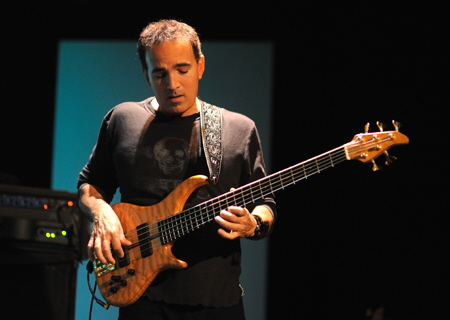
Ric Fierabracci, is an American professional bassist who has toured and / or recorded with artists such as Frank Gambale, Chick Corea, Sir Tom Jones, Dave Weckl, Bradley Joseph, Shakira, Nancy Sinatra, Planet X, The 5th Dimension, The Beach Boys, and Yanni. He appears in Yanni's live concert videos and albums Yanni Live at the Acropolis, Yanni Live at Royal Albert Hall and Tribute, the most recent tour during the 2003 Raza world tour. He also appears in Shakira's music video, "Inevitable." Fierabracci has performed as the home bassist at the Los Angeles jazz club "The Baked Potato", until he moved to New York City and has also contributed to numerous television and film jingles
TOP 10:
Abraham Laboriel
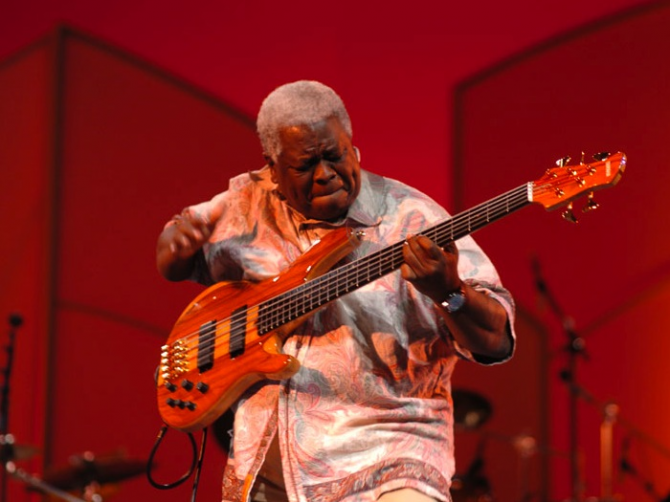
Abraham Laboriel (July 17, 1947) is a Honduran-Mexican bass player. He has participated in more than 4000 recordings and soundtracks. Guitar Player magazine described it as: "the most widely used session bassist of our time." He is the son of actor and composer Juan José Laboriel and actress Francisca López de Laboriel, is the brother of rock singer Johnny Laboriel, and is the father of drummer Abe Laboriel, Jr. and producer, composer and filmmaker Mateo Laboriel. Although currently a world-famous bassist, Abraham Laboriel, born in Mexico City, was originally instructed in classical guitar under the tutelage of his father, José Juan Laboriel, a Honduran, composer and guitarist of great talent. Having made his first recording at the age of 10 with a local rock 'n' roll group, and after performing in Mexico during his teenage years as a musician and actor, Laboriel began with bass attending classes at the Berklee School of Music in Boston, getting a degree in composition in 1972. There he recorded with a faculty member, the vibraphonist Gary Burton, and then toured with Johnny Mathis and Michel Legrand. He also worked with the famous composer and conductor Henry Mancini, who in 1976 persuaded Abraham to move to Los Angeles.1 This change proved to be the starting point of a diverse and immensely successful study career, playing and recording with great and diverse artists like George Benson, Ella Fitzgerald, Herbie Hancock, Joe Pass, Aretha Franklin, Dr. John, Robbie Robertson, Michael Jackson, Donald Fagen, Lee Ritenour, Larry Carlton, Dave Grusin, Andy Pratt, Stevie Wonder, Hanson, Barbra Streisand, Al Jarreau, Billy Cobham, Dolly Parton, Elton John, Ray Charles, Madonna, Paul Simon, Keith Green, Marcos Witt, Alvaro López and Res-Q Band, Lisa Loeb, Quincy Jones, Russ Taff, Engelbert Humperdinck, Umberto Tozzi, Ron Kenoly, Mylène Farmer, Crystal Lewis, Herbie Hancock, Chris Isaak, Paul Jackson Jr, His Presence among others. Among his numerous credits in movie soundtracks are Purple, Nine to Five and Terms of Endearment. In 1986, together with drummer Vinnie Colaiuta he recorded the bass for the central theme of the television series "Alf". In addition to his work with the groups Koinonía and Friendship, the latter with guitarist Lee Ritenour, Laboriel has released three solo albums - Dar Friends, Guidum and Justo and Abraham - that show his accomplished talent. As Larry Carlton once said: “There are many great bass performers in this world, but there is one, and only one Abraham Laboriel.” In 2005, Abraham was awarded a Doctorate in Honorary Music from the Berklee College of Music.
TOP 9:
Carles Benavent
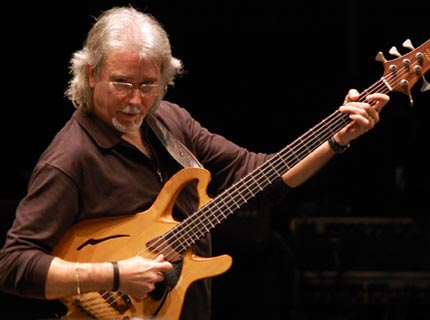
Carles Benavent (Barcelona, March 1, 1954) is a Spanish flamenco and jazz musician. Carles Benavent is a native of the Poble-sec neighborhood in Barcelona. Bassist, although he also doubles with the mandolin and the mandala, Benavent has played with Paco de Lucía, Chick Corea and Miles Davis, and it is usual to see him play with Jorge Pardo. Benavent who has worked in recent years on the so-called new flamenco, especially since his collaboration with Paco de Lucía, who left the impressive "Live in America" (1993). At age 13 he forms the group 'Crac' (which makes a mix of blues, jazz and rock, like many other groups of the time) with Salvador Font (drums) and Emili Baleriola (guitar). 1971 - The members of 'Crac' join Machine !, a band that marks a milestone in Spanish music of the time. 1973 to 1974 - Alternate work with jazz and Brazilian music groups. 1975 - He founded, together with Joan Albert Amargós (tec.), Salvador Font (bat.), Luigi Cabanach (guit.) And Lucky Guri (tec.) The group 'Urban Music'. After leaving the group first Guri and later Cabanach, Jordi Bonell (guit.), Jaume Cortadellas (transverse flute and piccolo) and Matthew L. Simon (trumpet, fliscorno and onoven; the latter is the fliscorno in my flat) . With this team they would record in the RCA the album "Iberia", where the mastery of the bass player is already clearly appreciated. 1979 - He plays in various jazz formations with musicians such as Kitflus, the violinist Mantequilla (Salvador Font the father), Tito Duarte and Max Sunyer, with whom he founded a trio together with Salvador Niebla. This year, an ephemeral group is also formed for live performances: Funky-jazz 80, with Benavent, Vladimiro Bas and Kitflus among other musicians. 1980 - This year he joins Paco de Lucía's group, touring Europe, America and Japan, sharing the stage with Jorge Pardo, Rubem Dantas and Ramón de Algeciras among others. 1981 - From now on he collaborates in numerous flamenco record productions: some of Camarón de la Isla and Paco de Lucía are among the best known. 1982 - Get in touch with Chick Corea, with whom he records two albums and makes two tours around the world. In the 80s he was part of the intermittent group "Puente Aéreo", in which musicians based in Madrid and Barcelona met: Tito Duarte, Jorge Pardo, Joan Albert Amargós, Kitflus, Max Sunyer, Jordi Bonell, Pedro Ruy-Blas , Rubem Dantas, Salvador Font the son ... 1983 - He recorded his first solo album, which is also released in Germany, Switzerland and Austria. He debuted with his own band at the IV Jazz Festival in Madrid, and formed a group with Jorge Pardo, with whom he recorded two albums. 1985 - Publishes his first album with Joan Albert Amargós: "Dos de Copas". Together with Jorge Pardo, he participates in the international festivals of Istanbul and Cork. 1986 - Performs at the Grenoble festival with Jorge Pardo. He receives the special prize of the critic awarded by RNE / RTVE and the magazine Quártica Jazz. 1987 to 1988 - He continues to tour around the world with the sextet of Paco de Lucía, and collaborates with the French violinist Didier Lockwood, and with the band of Bernard Lubat in France. 1989 - With the Flamenco Fusión group he acts in New York with Michel Camilo and Paquito D'Rivera. He recorded his second album with Joan Albert Amargós ("Colors"), which had the collaboration of Didier Lockwood among others. 1990 - He is invited, along with Jorge Pardo, the pianist and lately also accordionist Gil Goldstein, Don Alias and Alex Acuña, to give a special concert on Swiss TV (Schweizer Fernsehen); that concert gives rise to the band's performances in New York in October of the same year and the recording of a record on behalf of Gil Goldstein ("Zebra Coast") for the company Blue Note. From then on, Gil Goldstein regularly collaborates on the albums of Carles Benavent. 1991 - He is invited to play in a special concert in tribute to Gil Evans with Miles Davis and Quincy Jones at the Montreux Jazz Festival. That concert is also recorded in an album: "Live in Montreux". 1992 - It appears in the Town Hall of New York with Jorge Pardo, invited by the New Music Seminar. In July of the same year they participate in the German Jazzpaña project with the big band of the WDR in Colonia, with arrangements and direction by Ariff Mardin and Vince Mendoza. 1994: He is awarded by the Generalitat of Catalonia as the best jazz musician of the year. 1995: It publishes its fourth disc like soloist ("Agüita that runs"). On April 4 of that year he suffered a serious car accident that would take him away from the stage for a year. 1996: Just after one year after the accident, he begins a tour of Europe with Paco de Lucía and reappears with his group in July of the same year, performing at the Getxo Jazz Festival and in Barcelona, where he also
TOP 8:
Anthony Jackson
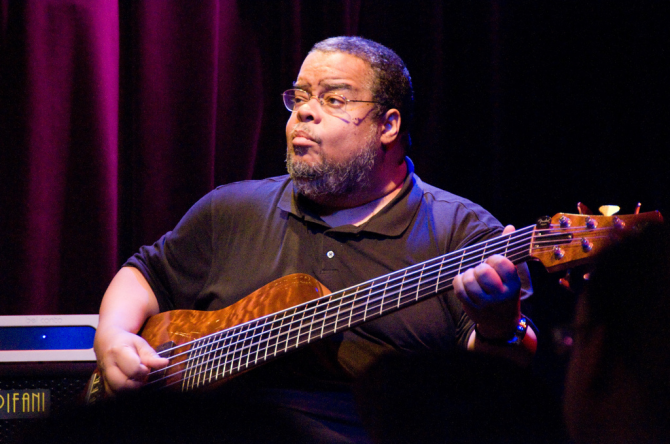
Anthony Jackson (born June 23, 1952) is an American bassist. He is considered one of the most important bass players in history, as it has extended the technical and idiomatic limits of the instrument, and has been key in legitimizing its use in jazz circles (although Jackson's career has developed in many more styles than the Jazz). Anthony Jackson has been a unique voice on the electric bass since he arrived on the New York music scene. In his youth he began playing the piano, before moving on to the guitar to finally, influenced by the legendary Motown bassist James Jamerson, adopt the electric bass as his main instrument. At age 18, Jackson began working as a session bassist, already having a great demand. Musicians familiar with Jackson know that he has a very personal style. This style can be partially attributed to Jackson's musical influences: James Jamerson - one of the most prominent bassists of the Motown factory, and the first virtuoso of the bass; Jack Casady, of the Jefferson Airplane group, and Olivier Messiaen, the French composer. Jamerson's influence on Jackson's style is easily discernible to any listener familiar with both bassists, especially on Jamerson songs such as "How Long Has That Evening Train Been Gone?" By Diana Ross and the Supremes. The use of arpeggios and passing notes for the simultaneous expression of harmony and rhythm, and brief passages in unison with the melody or other instruments are revealing. One of the most remarkable features of Jackson's style is his ability to have been inspired by the language of Jamerson - a soul musician - to apply it in any other style. Today, most Jackson recordings have nothing to do with any Motown recording, except for the obvious presence of Jamerson's influence. Perhaps more surprising to some will be the influence Jackson acknowledges having had on Jack Casady's part. “Casady, whom I first heard on Jefferson Airplane's 1966 album Surrealistic Pillow, had a big, rich, metallic and very thick sound, and a curious way of playing curious, guitaristic, which immediately attracted me. When I saw him play live, I was struck by his dignity and seriousness. ”Jackson said in 1990, in an interview in Bass Player magazine. (Note that this quote suggests Jackson's fascination with the relationship between bass and guitar - see below.). Casady played with a spike, a technique that has always been part of Jackson's repertoire. “It was Casady's sound that led me to explore the expressive possibilities of using the pick. Until today, when I use it next to a flanger, Casady's influence emerges and can be clearly detected by any fan. ”Jackson's other major influence is probably the least expected to be one of the main influences for a bass player . The music of composer Olivier Messiaen changed Jackson's life "irrevocably and forever", in his own words. It was the organ suite “La Nativité du Seigneur” by the French composer that so impressed Jackson, who stressed that “I hear the tritone as the central interval on which to build harmonies and melodies, as opposed to the third major or minor .. The tritone interval has been of paramount importance to me since the first day I heard Messiaen playing his own music on the organ. ”Listening to Jackson playing, especially in the freest contexts, you can hear tritons frequently, while moves through the fingerboard of his huge "double bass guitar" Fodera, 28 frets and 36 inches scale. Jackson and the six-string bass Jackson was the inventor of what has been called "six-string bass," a bass whose strings are tuned in si-mi-la-re-sol-do. His idea, which he christened "double bass guitar," was ahead of any standard six-string bass in more than twenty years. Jackson explains that his idea of adding more strings to the bass had its origin in the need to expand the tessellation of the instrument, and in his frustration with the loss of sound and sharp notes he experienced if he lowered the tuning of the four strings. When asked for his opinion on the criticism of the six strings, Jackson replies: “Why are four strings normal and not six? Being the most serious member of the guitar family, the instrument should have had six strings from the beginning. The only reason they were four is because Leo Fender was thinking of an instrument that had the function of a double bass, but he built it in the shape of a guitar because they are the instruments he built. The co
TOP 7:
Tom kennedy
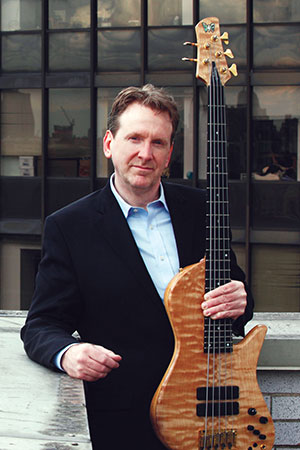
Tom Kennedy is an American bassist and bass player of jazz and jazz fusion. Son of a professional trumpeter, Tom Kennedy was a child prodigy. He had started on double bass at the age of 9, and shortly thereafter he was already one of the most requested musicians in the local scene of his hometown, St. Louis. Before he turned 18, Kennedy had a really enviable resume, which included performances by giants like Dizzy Gillespie, Sonny Stitt, Stan Kenton, James Moody, Barney Kessel, Eddie Harris, George Russel, Nat Adderly, Peter Erskine, Bill Watrous or Freddie Hubbard.1 Kennedy's interest had been directed towards acoustic jazz until he discovered the electric bass with 17 years, being immediately fascinated by the possibilities that the new instrument acquired in the hands of Larry Graham, Louis Johnson or Stanley Clarke .2 Thereafter, the musician's interests would be divided between more traditional jazz and contemporary fusion-funk.1 In 1984 he went to New York where he soon made a place as a bassist and bassist. Together with Dave Weckl (also originally from St. Louis) and guitarist Bill Connors, he forms a power trio called "Step It." Peter Erskine introduces him to Mike Mainieri who accepts him as bassist for his band Steps Ahead. At that time he also met the Brazilian singer and pianist Tania Maria, with whom he began a professional relationship that would last about 10 years. Other artists Kennedy works with at this time are Don Grolnick, Steve Kahn, Randy Brecker, Benny Green, Bucky Pizzarelli, Al DiMeola, Steve Ferrone, Junior Cooke, to name just a few. 1 Tom Kennedy is in everyone's credits and each of drummer Dave Weckl's albums, from "Master Plan" (his debut in 1990) to the most recent "Multiplicity." In 1997 he released his first solo album, which has collaborators of such a high level as Dave Weckl, Tania Maria, Sammy Figueroa or his brother Ray Kennedy and who is a good example of his versatility as a composer and as a performer. In 2004 he published a second work in his name, this time in the field of acoustic jazz, called Bassics, and continued with his busy schedule next to musicians like Mike Stern or projects like the Birdland Big Band. Clear heir of the Pastorius school, with a more modern and sophisticated sound as well as an exquisite technique, Tom Kennedy is considered one of the greatest jazz bassists of the contemporary scene. Its powerful groove and its characteristic solo phrasing, closer from the harmonic point of view to the wind instruments than to the electric bass, are evident in the enormous number of recordings that Tom Kennedy has carried out across the globe .1 The musician is a true teacher and a true virtuoso in both the Electric Bass and the double bass4 and an absolutely reference figure in the contemporary scene. Tom Kennedy uses Fodera instruments and Markbass amplifiers
TOP 6:
stanley clarke
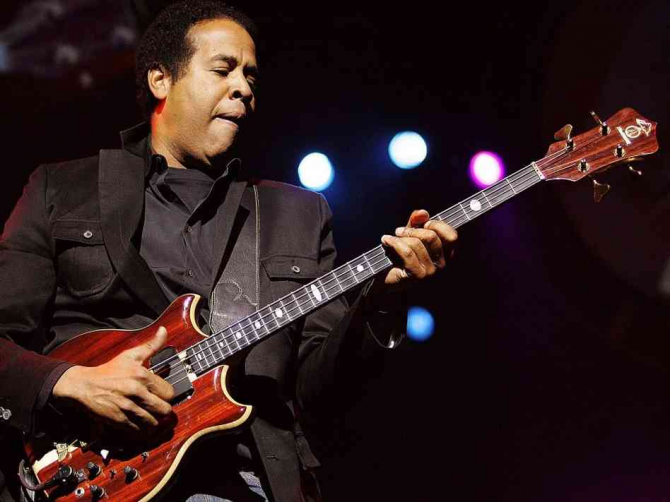
Stanley Clarke (Philadelphia, June 30, 1951) is an American bassist and bass player whose production, almost always linked to jazz, encompasses styles such as funk, fusion and post-bop. Clarke was born in Philadelphia (Pennsylvania). He played the accordion, the cello and the violin in his childhood. He worked in rythm and blues and rock bands during his teenage years, but after leaving for New York, he played with the avant-garde saxophonist Pharoah Sanders in the early seventies. Other companions were Gil Evans, Mel Lewis, Horace Silver, Stan Getz, Dexter Gordon and Art Blakey; Everyone was impressed by his talent. However, Clarke began his successful career by joining Chick Corea in his Return to Forever group. When this band was defined as a fusion quartet oriented towards Jazz Rock, Clarke worked primarily on the electric bass and became an influential force, preceding Jaco Pastorius in that musical movement of the 1970s. But starting with his album School Days (1976) and continuing with his funk group with George Duke (The Clarke / Duke Project), until his projects as a soundtrack composer, Stanley Clarke has continuously moved beyond the world of jazz, within the field of music commercial, taking as an example his participation in Animal Logic, next to the former drummer of The Police, Stewart Copeland. His 1988 album If This Bass Could Only Talk and his 1995 acoustic collaboration with Jean Luc Ponty and Al Di Meola The Rite of Strings, are two of his few jazz recordings since the seventies. In 1999, together with another former Return to Forever member, drummer Lenny White, they formed the Vertú band, inviting prestigious musicians such as guitarist Richie Kotzen, keyboardist Rachel Z and multi-faceted violinist Karen Briggs. This ephemeral Jazz Fusion group was the closest exponent to the musical essence of Return to Forever since its dissolution. In 2007 he presented "Thunder" along with two other bass players: Marcus Miller and Victor Wooten. The three started a tour in 2008 that began in the USA. and ended on October 31 in Almeria (Spain).
TOP 5:
Gary willis
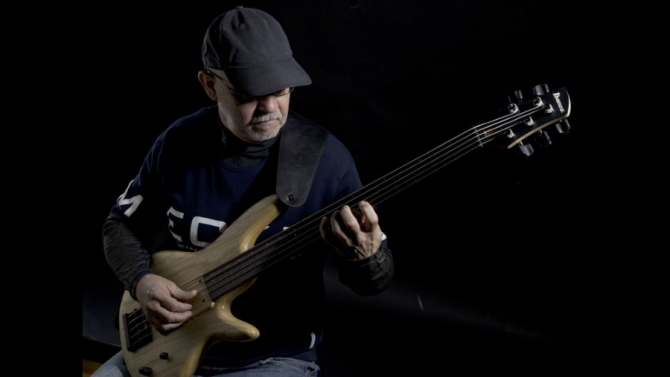
Gary Willis is an American musician specializing in fretless bass, known primarily for his work with the jazz fusion group Tribal Tech. Born in a family with a strong musical inclination, Gary Willis began playing the electric bass at the age of thirteen years, when, hearing his father, he realized that it was the left hand of the pianists that established the groove and seemed to lead the music. When, in his second year of university career, he was forced to sell one of his instruments to be able to return the scholarship that would allow him to continue his studies, he decided to get rid of his Les Paul guitar, keeping his P-bass and confirming his bassist vocation definitively. In 1984 the musician founded, along with guitarist Scott Henderson the band Tribal Tech, one of the most famous groups of the Fusion Music post Weather Report, with which he would remain 16 years and that he would definitely establish him as one of the most admired young bassists of his generation.1 Parallel to his career with Tribal Tech, the bassist has maintained an important independent career that has developed at three different levels: Cultivating, on the one hand, his personal career with the recording of three solo albums; developed, on the other hand, a significant series of collaborations that has led him to work with names such as Allan Holdsworth, Wayne Shorter or Dennis Chambers; and developing, finally, an important teaching activity, which Willis has materialized with the publication of four educational books: Fingerboard Harmony for Bass, "The Gary Willis Collection, Ultimate Ear Training for Guitar and Bass and 101 Bass Tips. Disappointed with the limited support of record companies to use, 2 Willis decides to take a small season of musical semiretiro, settling in Santa Fe, New Mexico, where he works temporarily as a web designer and even as a private detective.3 However, his transfer to Barcelona, where he has known his wife and where he has been living for several years, it meant for Willis the resumption of his musical activities: There, together with saxophonist Llibert Fortuny and drummer Kirk Covington, he formed in 2006 the collective improvisation project Slaughterhouse 3, recorded his album Actual Fiction taking care of practically all the instruments and programming and continues his practice as a teacher. Gary Willis is one of the greatest exponents of the electric bass guitar today.1 It has been in his five-string fretless bass guitar, where the artist has developed a unique and absolutely personal language, which clearly captures the heritage of Jaco Pastorius to elaborate and develop your system by exploring the technical possibilities of your instrument to the fullest.4 But Willis virtuosity is not reduced only to his technical skills, but - and above all - to his sophisticated vocabulary, which he has found in the intricate and often obscure harmonies of the themes of Tribal Tech its ideal means of expression. The innovative style of Willis, which has its roots in its strong conviction that the ideal of every musician should not be other than to achieve the ability to instantly execute everything he can imagine, 5 is characterized by advanced phrasing that, while delineating absolutely unusual harmonic patterns, does not lose contact with the groove and improvised character of his music, two of the fundamental pillars in the artist's technique. Willis not only shares with Henderson the leadership of Tribal Tech, but also the responsibility in the group's compositions, so that the influence between the two musicians in their double facet of composers and instrumentalists seems to be reciprocal. The bassist also admits the influence of artists such as Jaco Pastorius, Francis "Rocco" Prestia or Paul Jackson, bassist of the Headhunters as his main sources of inspiration in the instrument. Gary Willis maintains a close relationship with the firm Ibanez, which maintains in its catalog the GWB 1005 model, a five-string fretless instrument, designed in conjunction with the bass player.
TOP 4:
Richard Bona
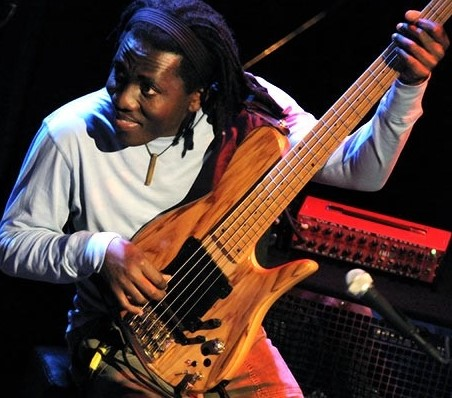
Richard Bona is a Cameroonian jazz and jazz fusion singer, songwriter and multi-instrumentalist, specializing in electric bass, an instrument of which he is one of the greatest exponents of today. Bona was born on October 28, 1967 in Minta, a small town in eastern Cameroon. Richard began playing the balafon with only four years, stimulated by his mother and grandfather, who had built the instrument that the boy played more than twelve hours a day.1 At five years old, little Bona was already performing at the local church, where It quickly became a small local legend, a child prodigy whose shows at weddings, baptisms and small parties everyone wanted to contemplate. With 11 years he moved with his father to the port town of Douala and there he realized that to attract more public he would need to learn a new, more modern instrument. Using flutes and guitars that he himself had made with oil cans and bicycle wires, he finally found work as a guitarist2 in a Douala band. In 1980 the owner of a local club asked Bona to form a jazz band for his establishment, giving him access to his vinyl collection. When Bona was impressed by Jaco Pastorius' debut album, he decided to change the main instrument, adopting the electric bass as the main instrument ever since. After the death of his father in 1985, Bona decided to leave Cameroon to settle in Paris in 1989 with only 22 years. There his fame as a virtuoso only grew in each of his appearances in local jazz clubs, along with musicians such as Didier Lockwood, Marc Ducret, Manu Dibango or Salif Keïta. Richard continued to deepen his study of the work of great jazz musicians such as Miles Davis, Chet Baker or Ben Webster. He enrolled in a music school to hone his skills as a composer and created his own band called Point Cardinale. Finally, keyboardist Joe Zawinul, in his constant search for new talents, noticed the presence of the young bassist in Parisian clubs and signed him for his 1992 album We the people, which marked the bass debut of the bassist as a companion of a name of international relevance. In 1995, encouraged by guitarist Mike Stern, Bona left Paris to settle in New York, whose jam scene would cause an immediate and remarkable impact; Suddenly, Richard found himself working with the biggest names in the world jazz scene, such as Mike Stern, Randy Brecker, Michael Brecker, Bob James, Chick Korea, Bobby McFerrin or Branford Marsalis among many others. In 1998, Bona recorded the first of his four solo albums, Scenes From My Life, and a year later he would embark as a chorus and percussionist on a world tour with Pat Metheny Group, alongside Steve Rodby, the band's bassist. In 2004 Bona forms her own fixed sextet with which she has toured the main jazz festivals in the world. Although since then the musician has focused on his solo projects, he still maintains a busy schedule of collaborations, in addition to acting sporadically with Mike Stern, Steps Ahead or the Jaco Pastorius Big Band in different locations in New York. It is easy to verify by a quick glance at his career that Bona has worked with the most important musicians of the New York scene, and that he has done it covering a wide variety of stylistic records, ranging from jazz to funk or pop.3 Bona is a very capable singer and a multinstrumentist with an incredible natural ability to learn to play any new instrument just by watching how it is performed.4 In regards to his contributions to the electric bass, Bona is one of the greatest virtuosos of the news and one of the figures that attracts the most attention from specialized magazines and instrument enthusiasts. Bona is a musician and composer rather than bassist, and his music is an integral work where each instrument has a role designed to contribute equitably and musically to the essence of the theme5 and a space whose center is occupied by the melody, and not by any particular instrument . This conception, in addition to contributing to bringing Bona's proposals closer to a much wider audience, has provided him with credibility as a composer among specialized critics that it is not easy to find in many of his bearish colleagues. The language of Bona in its double aspect of composer and musician, reflects its many and varied influences (from the complex harmonies characteristic of jazz6 to the intricate polyrhythms characteristic of traditional African music, through the importance of the melody that derives from interest of the musician in pop and soul). Although Richard Bona has a large arsenal of electric basses, he has been holding an endorsem contract for years
TOP 3:
Marcus Miller
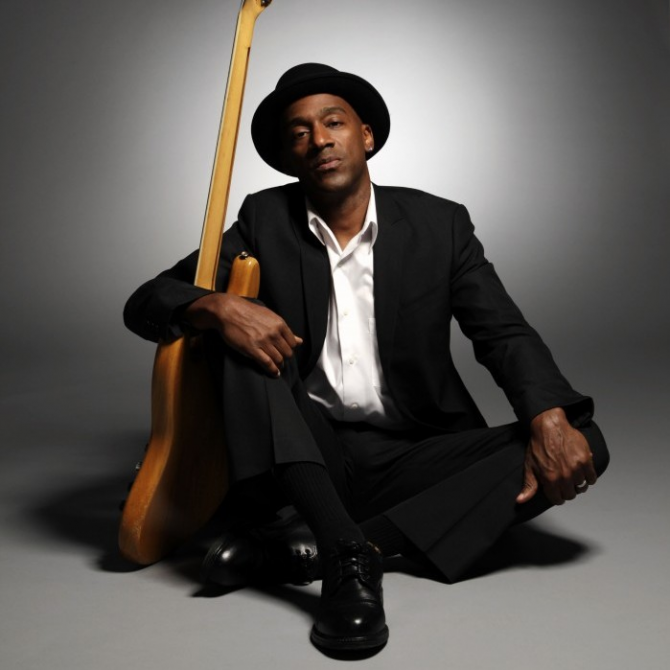
Marcus Miller (New York, June 14, 1959) is a jazz musician, composer and producer. His best-known works are as bassist in conjunction with trumpeter Miles Davis, Luther Vandross and David Sanborn. Miller studied clarinet academically but sometimes he also plays the keyboard, the saxophone, the guitar and stands out as a bassist. Marcus Miller was born in Brooklyn (New York) in 1959. He was educated in a large musical family, since his father was an organist in the church and choir director, a circumstance that influenced him a lot from an early age, showing an early affinity for all kinds of music. With 13 years he played with clarinet, piano and bass, and took his first steps in the composition of music. He chose the electric bass and at 15 he was already working regularly for the New York clubs in several groups. Marcus Miller, spent the following years in high demand as a session musician in the recording studios in New York, working with Aretha Franklin, Roberta Flack, Grover Washington Jr., Bob James and David Sanborn, among some others. In 1981 he joined the band that was his idol since childhood, the trumpeter, Miles Davis, with whom he stayed for two years. Marcus alternated record production with live performances with different artists and with "The Jamaica Boys" R&B band that co-led a couple of years, recording two albums with them. At that time, he devoted all his attention to record production, his first major production being the "Voyeur" album for David Sanborn, in 1980, which earned him a Grammy award, thus beginning a close and lasting collaboration between both musicians who He continued with the production, years later of other highly successful albums: "Close Up" (Reprise, 1988); "Upfront" (Elektra, 1992); and "Inside" (Elektra, 1999), winner of another Grammy in 2000. In 1986, Marcus Miller, returned to collaborate with Miles Davis, producing the extraordinary album "Tutu", one of the emblematic albums of the electric stage of Thousands. After many years of working as a producer and session musician, Miller published in 1993, his first album in his name entitled: "The Sun Don't Lie" with a regular welcome. However, the following year he would compensate by publishing "Tales" a colorful landscape of the evolution of black music. In 1997 he published for the GRP the live "Live And More" an extraordinary concert and at the entrance of the third millennium, he released his album "M2". (JVC Japan, 2001). In recent years, Miller has spent his professional time in composing music for the Cinema. His were the soundtracks of the films: "House Party" and "Boomerang" with Eddie Murphy, "Siesta" with Ellen Barkin; "Ladies Man" with Tim Meadows and "The Brothers" with Morris Chestnut and DL Hughley. He also composed and produced the hit song "Old School Da Butt" for the soundtrack of the film "School Daze", by the excellent director, Spike Lee. Marcus Miller, continues his ongoing task of approaching jazz music, the amazing sounds of his electric bass. In 2007, he presented "Thunder" along with two other bass players: Victor Wooten and Stanley Clarke. The three started a tour in 2008 that began in the USA. and ended on October 31 in Almeria (Spain). In 2009, he collaborated on the new album by Italian guitarist Flavio Sala, playing on the theme that gives the album its name, De La Buena Onda, along with Jorge Pardo, Toninho Horta and Cliff Almond.
TOP 2:
Victor Wooten
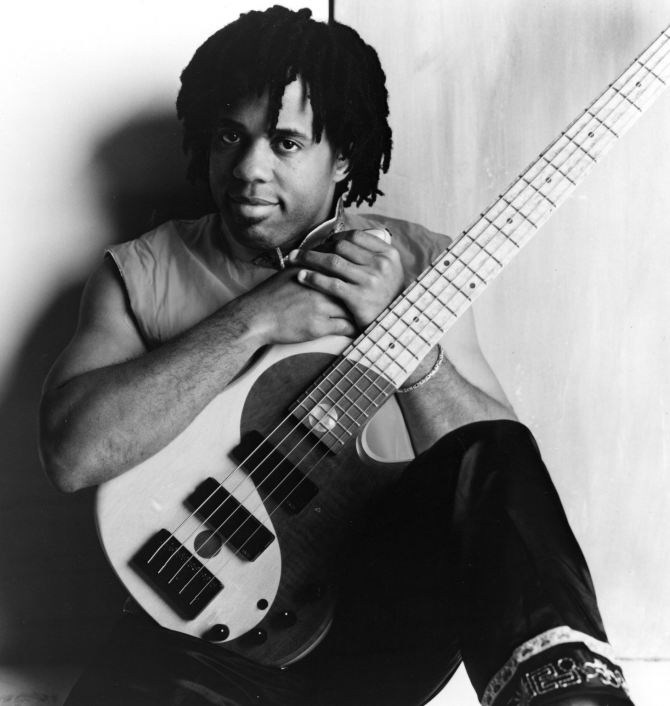
Victor Lemonte Wooten (born September 11, 1964) is a virtuoso American bassist and is considered one of the best bassists of the 1990s and 2000s. The youngest of 5 brothers Victor Wooten, at two years old, his brother Regi taught him playing bass, with 5 years Victor could play simple lines and concerts. The band of the Wooten five, formed by Regi, Rudy, Roy, Joseph, Victor and Ross played during the 1970s in the city of Williamsburg, Virginia at the Busch Gardens theme park and was the opening act for Curtis Mayfield and War. After moving to Nashville, Tennessee in 1988 Victor was immediately recruited by blues and soul singer Jonell Mosser. A year later, he joined Banjo master Béla Fleck, along with Howard Levy, who played keyboard and harmonica and Victor's brother, Roy Wooten as drummer. His group, Béla Fleck and the Flecktones, became famous by playing a mix of jazz, funk and Bluegrass, later becoming one of the most stylistically uninhibited bands on the scene. (Levy left the group and was replaced by the saxophonist and tubist Jeff Coffin.) Wooten has also been a member of several bands with already established members, such as Bass Extremes (with Steve Bailey, Derico Watson and Oteil Burbridge), Vital Tech Tones (with Scott Henderson and Steve Smith), and the trio Extraction (with Greg Howe and Dennis Chambers). Victor has also been touring with many bands, including Dave Matthews Band. In 2007 he presented "Thunder" along with two other bass players: Marcus Miller and Stanley Clarke. The three started a tour in 2008 that began in the USA. and ended on October 31 in Almeria (Spain). The evolution in the methods of construction of electric basses, like a lower action (distance between the string and the fretboard) resembling a 4-string guitar, allowed Wooten to develop new pulsation techniques that had virtually not been discovered in the epoch. He developed the double-thumb (or double thumb) technique created by Stanley Clarke, who uses the thumb and thin strings (of low caliber) similar to the guitar pick along with the funky slap technique, and the open technique -hammer-pluck (slap-hammering-pop), which he sometimes uses together with multiple hammer-on (hammering). Wooten normally plays Fodera basses, of which he has a signature (custom) model. Its most famous bass (which Wooten calls number one) is a 1983 Fodera Monarch Deluxe, it has a 2400 Kahler tremolo bridge. The "Yin Yang" Fodera basses (designed and created for Wooten) incorporate the Ying Yang symbol ( that Wooten uses as merchandising). It may be thought that the symbol is painted on the bass, but they are really two pieces of ebony and holly in natural finish, joined to create the symbol. Although Wooten's basses receive a lot of attention, his most frequent response to fans is that "the bass doesn't make music ... you make it" and continues to argue that the most important characteristic of a bass is its comfort when playing, this is related to Wooten's belief that music is a language, then, just like when one speaks and we look at words instead of in the mouth, in the same way, when listening to music we should not focus attention on the instrument .
TOP 1:
John patitucci
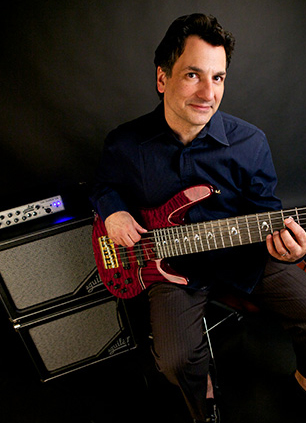
John Patitucci (born in Brooklyn, New York, on December 22, 1959) is an American jazz bassist and bass player specializing in what has come to be called fusion music. Patitucci began his professional career in the early '80s, participating in countless recording sessions next to figures such as BB King, Michael Brecker, Dave Grusin, Herbie Hancock, Dizzy Gillespie, Stan Getz, Bonnie Raitt, Sting, Wayne Shorter, or George Benson, and recording under the direction of important composers such as Jerry Goldsmith and John Williams or Henry Mancini. Already at that time Patitucci showed a special interest in the music of Brazil, as evidenced by his collaborations with Astrud Gilberto, João Gilberto, Airto Moreira, Flora Purim, Ivan Lins, Milton Nascimento or Joao Bosco; This interest has since been a constant in his career. In the mid-1980s, while he was voted by his colleagues at the "National Academy of Recording Arts and Sciences" as "Best Study Bassist" of the year, he entered the two parallel projects of keyboardist and pianist Chick Korea, the Elektric Band and the Akoustic Band, where he played electric bass and double bass, respectively. The exhibition he would achieve with both formations, with which he would record numerous studio albums and perform worldwide, quickly established him as one of the reference bassists in the international jazz scene and awarded him two Grammy Awards and eight nominations. In 1987 he recorded his first solo album, simply titled "John Patitucci", which reached the top of the Billboard Jazz charts and that would inaugurate a long list of acclaimed recordings for the GRP label that, in turn, would select him as the bassist official of his Big Band of "All Stars". Since 1995 the bassist has released his albums under the "Concord Jazz" label. During the 1990s, Patitucci received a long list of awards, being voted "Best Jazz Bassist" for four years in a row by "Bass Player" magazine.2 Since then, in addition to continuing with the projects he had started with Korea, with his indefatigable work as a "sideman", and as an independent composer, Patitucci carried out original projects in Europe (with the Italian chamber orchestra "Suono e Oltre") and Japan (New Japan Philharmonic Orchestra in Tokyo) with which they place it between the most innovative and restless jazz musicians on the current scene. John Patitucci is also a highly respected and active figure in the field of education: among other activities, he has for years maintained a strong bond with the "Thelonious Monk Institute of Jazz" and is director of the "Bass Collective", a prestigious New York Institute for Bassists, where the bassist resides since 1966. He has also edited various teaching methods widely spread among the bassist community. John Patitucci is a key figure in the recent history of the electric bass, a virtuoso of his instrument and a model for countless bassists.3 Along with Stanley Clarke, he has been one of the first musicians to achieve an almost absolute technical mastery of both the electric bass Like the double bass. Together with Anthony Jackson, and at the head of the Chick Korea bands he has perhaps contributed more than any other bass player, to popularize the six-string bass. The bassist has developed a very advanced and complex post-bebop language, easily recognizable in the frequent solos that he performs with incredible technical precision, great harmonic sophistication and a crystalline sound that, in the electric bass, he obtains from his instruments Ken Smith and Yamaha, With enormous musical versatility, and endowed with an encyclopedic knowledge of the history of his instrument and the bassists who have preceded it, Patitucci can be considered as one of the architects of the sound and language of modern bass.

